
Delivery, an issue for the transport of tomorrow #2 An encounter with Emmanuel Bonnaud
3 minutes of reading
According to the UN News Centre, over two thirds of the global population will live in towns and cities by 2050. What with the increase in population and evolving ways of life and of consumption, urban centres are undergoing an in-depth transformation, accompanied by changing requirements in terms of mobility.

In collaboration with the Chronos research bureau and with numerous experts in this area, we study the way cities are adapting to mobility issues. Emmanuel Bonnaud, Deputy Director of Urban Logistics for the La Poste group agreed to explain to us his Group’s strategy for optimising the flow of goods. A novel example of the way in which companies now envisage the city of tomorrow.
 BYCN: You talk about a form of ‘schizophrenia’ with regards to resident-consumers. How do you define this attitude?
Emmanuel Bonnaud: We now find ourselves at a crossroads. As consumers, we are making more and more purchases online because it’s so convenient and economical, and delivery times are getting shorter and shorter; you only have to look at the e-commerce sites like Amazon who promise next-day delivery. On the other hand, we are also residents who aspire to live in a pleasant environment largely made up of pedestrianised areas and local shops, with no lorry traffic, etc.
These two models are mutually contradictory. By their very nature, offers of free, rapid delivery are a threat to local shops and to the optimisation of the flow of goods. They also contribute to endangering the jobs of delivery workers with the appearance of models such as Deliveroo and UberEats, which one may imagine will soon be applied to all goods. At the La Poste Group, we believe urban logistics to be a response to this issue.
BYCN: What solutions have been put in place by the La Poste Group to respond to this issue?
Emmanuel Bonnaud: Our strategy focusses on several different areas:
First, a fleet of cleaner vehicles. We now have the largest fleet of electric vehicles in the world (11,000), which are better both for the environment and for the health of the local people.
Secondly, warehouses are located on the outskirts of towns and cities to limit traffic in urban centres. Large delivery lorries are currently 20 to 30% full on average; we propose allowing them to deliver their goods to shared centres on the outskirts of towns and then providing delivery by vehicles more suited to town centres.
Finally, we suggest optimising delivery methods within cities. Lorries are not at all suitable for city-centre deliveries. This is why we are aiming to develop new models for our deliverers while making the job less arduous. We have now developed the use of cargo-bikes and are also working on the use of internet-enabled trailers for our delivery personnel on foot. We are currently developing a project with the startup Effidence, also used by Bouygues Construction, to make the work of our delivery personnel less arduous.
BYCN: You talk about a form of ‘schizophrenia’ with regards to resident-consumers. How do you define this attitude?
Emmanuel Bonnaud: We now find ourselves at a crossroads. As consumers, we are making more and more purchases online because it’s so convenient and economical, and delivery times are getting shorter and shorter; you only have to look at the e-commerce sites like Amazon who promise next-day delivery. On the other hand, we are also residents who aspire to live in a pleasant environment largely made up of pedestrianised areas and local shops, with no lorry traffic, etc.
These two models are mutually contradictory. By their very nature, offers of free, rapid delivery are a threat to local shops and to the optimisation of the flow of goods. They also contribute to endangering the jobs of delivery workers with the appearance of models such as Deliveroo and UberEats, which one may imagine will soon be applied to all goods. At the La Poste Group, we believe urban logistics to be a response to this issue.
BYCN: What solutions have been put in place by the La Poste Group to respond to this issue?
Emmanuel Bonnaud: Our strategy focusses on several different areas:
First, a fleet of cleaner vehicles. We now have the largest fleet of electric vehicles in the world (11,000), which are better both for the environment and for the health of the local people.
Secondly, warehouses are located on the outskirts of towns and cities to limit traffic in urban centres. Large delivery lorries are currently 20 to 30% full on average; we propose allowing them to deliver their goods to shared centres on the outskirts of towns and then providing delivery by vehicles more suited to town centres.
Finally, we suggest optimising delivery methods within cities. Lorries are not at all suitable for city-centre deliveries. This is why we are aiming to develop new models for our deliverers while making the job less arduous. We have now developed the use of cargo-bikes and are also working on the use of internet-enabled trailers for our delivery personnel on foot. We are currently developing a project with the startup Effidence, also used by Bouygues Construction, to make the work of our delivery personnel less arduous.
 BYCN: How would you describe the ideal city?
Emmanuel Bonnaud: For me, the ideal city operates within an optimised urban logistics scheme whereby proximity in terms of land use is embraced and where delivery vehicles can circulate outside peak times to supply sites in the city.
It is also a city where artificial intelligence and data are used to better identify consumer habits and delivery transport flows in order to optimise stock management, but that is a whole other story!
BYCN: How would you describe the ideal city?
Emmanuel Bonnaud: For me, the ideal city operates within an optimised urban logistics scheme whereby proximity in terms of land use is embraced and where delivery vehicles can circulate outside peak times to supply sites in the city.
It is also a city where artificial intelligence and data are used to better identify consumer habits and delivery transport flows in order to optimise stock management, but that is a whole other story!

Emmanuel Bonnaud, Deputy Director of Urban Logistics for the La Poste group

Effibot – All rights reserved
Most read
More reading
Read also




What lies ahead? 7 megatrends and their influence on construction, real estate and urban development
Article
20 minutes of reading

